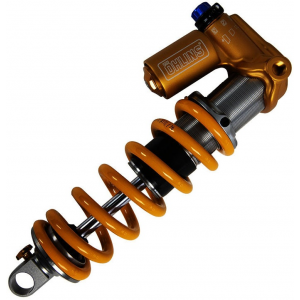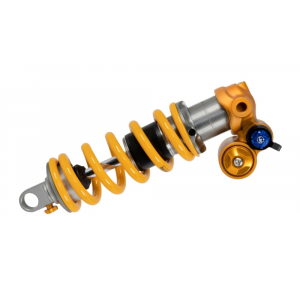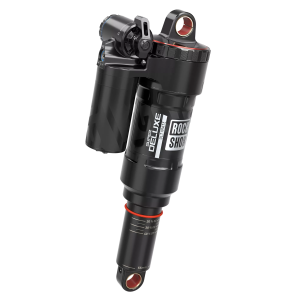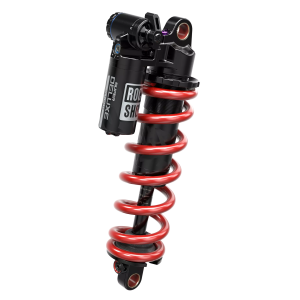Öhlins TTX22m.2 Rear Shock
| Where To Buy | |||
|---|---|---|---|
Free shipping on orders over $50 (continental U.S. only).
International shipping available. Some exclusions apply. |
Free shipping on orders over $50 (continental U.S. only).
International shipping available. Some exclusions apply. $800.00
|
||
Free shipping on orders over $50 (continental U.S. only).
International shipping available. Some exclusions apply. |
|||

The TTX22m has now been around for 10 years, and during that time no major changes have been made to the core, twin-tube architecture of this iconic coil shock that made its MTB debut on Specialized bikes at the end of 2012. Metric and Trunnion versions were added a few years ago as the shocks became more widely available both for OEM and aftermarket fitting, and Öhlins also played around with the physical orientation of the piggyback cylinders to allow the shock to fit more frames, but throughout it all, the underlying architecture was left pretty much unchanged. Given that the track record and the performance levels of the TTX22m pretty much still tick all the boxes, there was no apparent need for a major overhaul, so we almost sighed with relief when the TTX22m.2 showed up and proved to be very much an evolution and not a revolution. Nevertheless we’ve put it to the test to make sure it still is what it is – a good thing.
Strengths |
Weaknesses |
|---|---|
|
|
Öhlins TTX22m.2 Highlights
- TTX technology
- Specifically designed for trail and downhill use
- 250/225 length with golden DH compression valve; blue trail valve for all other lengths
- Available in metric lengths/strokes
- Standard side-by-side cylinder head or inline versions available
- Standard mount sizes: 210x55/52.5/50/47.5mm // 230x65/62.5/60/57.5mm // 250x75/72.5/70/67.5mm
- Trunnion mount sizes: 185x55/52.5/50/47.5mm // 205x65/62.5/60/57.5mm // 225x75/72.5/70/67.5mm
- Possible to adjust stroke simply with the three 2.5 mm spacers included in the box
- Suitable for Öhlins lightweight springs with 4 Nm/23 lbs increments
- External, 3 level high-speed compression adjustment
- External, 16 click low-speed compression adjustment rebound damping adjustment
- External, 7 click rebound adjustment
- Weight: 486g (for trunnion shock 205x65, excluding spring)
- MSRP: $795 USD (excluding spring)
Initial Impressions
Let’s start things off with a brief explanation of what makes a twin tube damper so special: during compression in a traditional damper, without the twin tube design, all displaced damper oil has to go through the main piston and the volume displaced by the piston goes to the gas reservoir. When this occurs, there is a higher pressure on the compression side of the shim stack and lower pressure on the other. The twin, re-circulating tubes allow Öhlins play with what oil goes where to eliminate that pressure difference. Adjusting the compression settings changes the percentage of oil that goes through the piston versus what goes around the bypass tube.

Why is this beneficial? It all comes down to response time. In traditional shocks, oil is getting compressed to a greater extent, and when you switch from compression to rebound, the oil has to expand as well (that squishy noise you often hear). In the twin tube shock, internal pressure changes are less dramatic, which enables the shock to reverse directions quickly while maintaining consistent damping, even on very short stroke movements. Öhlins says that creating damping force at lower pressures has a huge effect on the response of the shock. The difference between the two designs becomes more apparent if you raise the temperature and cycle frequency (think faster repeat hits on the trail). Öhlins claims the design eliminates the possibility of cavitation (bubbles forming in the oil on the low-pressure side) and the damping inconsistencies that can result, because there is no massive pressure drop when the piston changes directions. Lower pressures also allow them to use thinner walls which translates to less weight.



As mentioned in the intro, Öhlins kept the core architecture of the TTX22m unchanged for the m.2 version. They have however made several key improvements to offer greater adjustment range and allow the shock to be used with more frames:
- Improved bottom-out control thanks to a redesigned bumper and bumper cup. The new bumper provides support earlier on in the stroke which provides a more progressive overall spring rate curve, which should be beneficial to less progressive frames.
- The stroke of the shock can be adjusted externally by simply adding or removing spacers under the bottom-out bumper. It is also easier than before to swap out the spring, as you no longer have to remove the rebound damping dial to do so.
- Side-by-side and inline reservoir layouts available to improve compatibility with more frames.
- Wider adjustment range on the high-speed compression dial on the “trail” version of the shock, with stiffer pedal-mode tune.

On The Trail
We fitted the TTX22m.2 shock to a YT Capra MX (mullet), where it actually replaced the stock TTX22m. Back-to-back, we did not notice and major changes in behavior – indeed a good thing, as there was nothing wrong with the previous generation at all. The TTX22m.2 is quite easy to set up, once you figure out the correct spring rate for your frame, body weight and riding style, it’s a matter of dialing in rebound to taste and using the compression damping adjustments to fine tune your bike’s handling.

The dials provide what Öhlins has always called a “usable range” of adjustments. The idea here is that you should be able to ride your bike even if you (inadvertently or on purpose) should happen to max out any of the adjustments. This also means that you will get less extreme “parking lot” settings, for example, you can’t slow the rebound down to a crawl which some riders may find unnerving at first (“does my shock work? Is the damping blown?”).


The standout characteristic of the TTX22m.2 is just how settled it is in action. It provides a very planted feel and never seems to be overwhelmed, yet it retains enough liveliness to keep the fun factor high. Bunny hopping and taking off on smaller lips is about as poppy as you could have any right to ask for with a coil shock, and the bike never feels sluggish despite the high levels of grip and control generated. The adjustment range also proved to be spot on for this 190-lbs tester, he landed close to the middle of both rebound and low-speed compression damping. On a progressive frame like the Capra, the high-speed compression dial is generally best left open, to enjoy the feeling of an open shock while still retaining perfect bottom-out control. Bigger landings are smooth and uneventful, and the transition onto the bottom-out bumper is linear and devoid of any sudden spiking.

One quirk of the TTX22m is the fact that the pedaling platform setting is activated at the third (last) click of the high-speed compression dial. It is a bit counter-intuitive to find it here, but in practice it makes little difference as there are only three clicks on this dial anyway. This means you can effectively choose from two high-speed compression settings only, while the third position is used for climbing. Just remember which high-speed compression setting you want to go back to after the climb is over and you’re good to go. The DH version of the shock gets three high-speed compression settings instead (the DH version has a thin golden strip under the high-speed compression dial, whereas on the trail version this part is blue). In action, the pedaling platform is reasonably stiff, and will help combat any pedal-induced bobbing present in your frame (we didn’t find a significant difference between the stock TTX22m and the TTX22m.2 in this regard, but it would probably be hard to feel this difference on the trail anyway). It is not a lockout, but rather it slows down the compression damping to where bobbing becomes less of an issue. This also means you don’t fully get the same feeling of support as you will with a RockShox climbing platform for example, which effectively almost locks out the rear suspension and also holds you higher in the bike’s travel as a result. Horses for courses, and those who do a lot of technical climbing might well prefer the more active option anyway.


Things That Could Be Improved
We were stoked to find that the spring can now be swapped without having to remove the rebound adjustment knob. We were less stoked to find that as a result, the rebound knob is smaller and harder on your fingers. Let’s call this a first-world problem. We also think that the pedaling platform could be made a little bit stiffer still, although if you like technical climbing you’ll probably appreciate that the shock still remains active enough to deal with the terrain even with the pedaling platform activated.
Long Term Durability
We’ve been running TTX22m shocks on some of our bikes for many years by now. It is probably the shock that gives us the least amount of trouble, especially considering our blatant disregard for all things service interval related - the TTX will take a beating and keep on trucking. The shock is still made in Sweden (as opposed to several other Öhlins suspension products which are made in Taiwan these days), whether or not that is the reason for the very impressive reliability we don’t know, but the fact remains – if durability is high on your list of requirements, the TTX22m.2 fits the bill.
What’s The Bottom Line?
A good piece of equipment is one that lets you get out there and ride your bike, as hard and as often as you like. That’s exactly what the TTX22m.2 was built for, and it hits it out of the park. It provides a very high level of comfort and control, helping your bike stick to the ground but while retaining a level of responsiveness that keeps things fun on the trail. It is easy to set up with a fully usable range of damping settings and lightweight springs available in 23-lbs increments, and the stroke of the shock can be adjusted externally with a set of simple spacers included in the box. The shock will put up with long service intervals and still provide years of loyal service. Swedish squish at its best!
More information at: www.ohlins.com.
About The Reviewer
Johan Hjord - Age: 49 // Years Riding MTB: 17 // Weight: 190-pounds (87-kg) // Height: 6'0" (1.84m)
Johan loves bikes, which strangely doesn’t make him any better at riding them. After many years spent practicing falling off cliffs with his snowboard, he took up mountain biking in 2005. Ever since, he’s mostly been riding bikes with too much suspension travel to cover up his many flaws as a rider. His 200-pound body weight coupled with unique skill for poor line choice and clumsy landings make him an expert on durability - if parts survive Johan, they’re pretty much okay for anybody. Johan rides flat pedals with a riding style that he describes as "none" (when in actuality he rips!). Having found most trail features to be not to his liking, Johan uses much of his spare time building his own. Johan’s other accomplishments include surviving this far and helping keep the Vital Media Machine’s stoke dial firmly on 11.
Photos by Johan Hjord and Nils Hjord
1 member reviews
Very robust, used it for many years, sent for service, not because it felt bad but because I wanted to be a good boy, but the service technician basically said there is nothing wrong with it.
Robust, plush damping, just works out of box. I fiddled with the damping and to be honest I didn't need to as it is already setup on a great window.
It could be a bit more silent though.
Very happy with this.
0 comments
Post a reply to: Fit and forget
Specifications
• 210x55/52.5/50/47.5mm
• 230x65/62.5/60/57.5mm
• 250x75/72.5/70/67.5mm
Trunnion mount sizes:
• 185x55/52.5/50/47.5mm
• 205x65/62.5/60/57.5mm
• 225x75/72.5/70/67.5mm
| Where To Buy | |||
|---|---|---|---|
Free shipping on orders over $50 (continental U.S. only).
International shipping available. Some exclusions apply. |
Free shipping on orders over $50 (continental U.S. only).
International shipping available. Some exclusions apply. $800.00
|
||
Free shipping on orders over $50 (continental U.S. only).
International shipping available. Some exclusions apply. |
|||

































7 comments
Post a reply to: Swedish Gold is Still the Standard: Öhlins TTX22m.2 Review